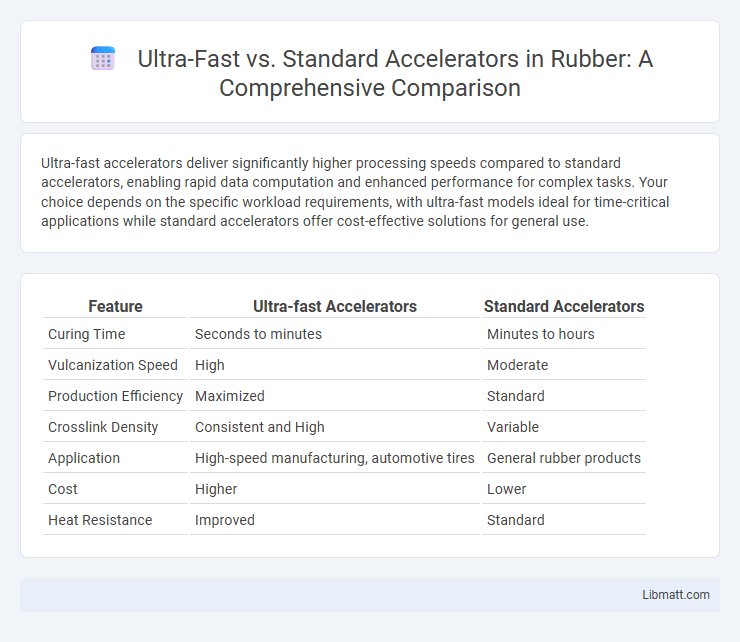Ultra-fast accelerators deliver significantly higher processing speeds compared to standard accelerators, enabling rapid data computation and enhanced performance for complex tasks. Your choice depends on the specific workload requirements, with ultra-fast models ideal for time-critical applications while standard accelerators offer cost-effective solutions for general use.
Table of Comparison
| Feature | Ultra-fast Accelerators | Standard Accelerators |
|---|---|---|
| Curing Time | Seconds to minutes | Minutes to hours |
| Vulcanization Speed | High | Moderate |
| Production Efficiency | Maximized | Standard |
| Crosslink Density | Consistent and High | Variable |
| Application | High-speed manufacturing, automotive tires | General rubber products |
| Cost | Higher | Lower |
| Heat Resistance | Improved | Standard |
Introduction to Accelerators
Ultra-fast accelerators deliver significantly higher performance by leveraging advanced materials and optimized designs to expedite particle collisions and data processing, surpassing the capabilities of standard accelerators which operate at conventional speeds for experimental consistency. These cutting-edge accelerators enhance scientific research and applications in fields like particle physics, medical imaging, and materials science by providing greater precision and efficiency. Your choice between ultra-fast and standard accelerators depends on the desired speed, accuracy, and application requirements.
Defining Ultra-Fast and Standard Accelerators
Ultra-fast accelerators are specialized hardware designed to significantly speed up complex computations, often leveraging parallel processing and high clock speeds to deliver superior performance. Standard accelerators provide enhanced computational ability primarily for general-purpose tasks but operate at lower speeds compared to ultra-fast variants. The distinction lies in processing power, latency, and application scope, with ultra-fast accelerators targeted at latency-sensitive workloads like AI inference and scientific simulations.
Core Technologies Behind Both Accelerator Types
Ultra-fast accelerators utilize cutting-edge semiconductor materials like gallium nitride (GaN) and advanced photonic technologies to achieve significantly higher processing speeds and efficiency compared to standard accelerators, which primarily rely on silicon-based transistors and traditional parallel computing architectures. Your choice of accelerator impacts performance, as ultra-fast options incorporate novel cooling solutions and high-bandwidth memory interfaces to minimize latency and maximize throughput. Core technologies driving ultra-fast accelerators also include AI-optimized processors and low-level hardware integration, setting them apart from the more generalized, widely compatible designs found in standard accelerators.
Performance Comparison: Ultra-Fast vs Standard
Ultra-fast accelerators deliver significantly higher computational speed, often exceeding standard accelerators by up to 10x in processing throughput and latency reduction. Standard accelerators cater to energy efficiency and cost-effectiveness, making them suitable for less time-sensitive applications. The performance gap is most evident in AI model training and high-frequency data analysis where ultra-fast accelerators dramatically improve execution time and real-time response.
Use Cases and Application Areas
Ultra-fast accelerators are ideal for applications requiring real-time data processing and high-frequency trading, enabling rapid decision-making and low-latency performance in financial markets and autonomous vehicle systems. Standard accelerators excel in machine learning training, scientific simulations, and video rendering where throughput and computational accuracy outweigh speed. Both types support AI inference tasks, but ultra-fast accelerators prioritize minimal latency, while standard accelerators offer balanced performance for large-scale data workloads.
Energy Efficiency and Cost Considerations
Ultra-fast accelerators deliver significantly higher energy efficiency by optimizing power usage per computation, reducing operational costs compared to standard accelerators. Standard accelerators may have lower upfront expenses but tend to incur higher energy consumption over time, impacting total cost of ownership. Your choice between ultra-fast and standard accelerators should balance initial investment with long-term energy savings to maximize overall cost-effectiveness.
Scalability and Integration Challenges
Ultra-fast accelerators deliver enhanced scalability for high-performance computing tasks, enabling seamless expansion of processing capabilities across multiple nodes. Standard accelerators often face integration challenges due to legacy system compatibility and limited support for heterogeneous architectures. Your choice between ultra-fast and standard accelerators should consider the ease of scaling workloads and the complexity of integrating with existing infrastructure.
Adoption Trends in Industry
Ultra-fast accelerators have gained significant adoption in high-performance computing sectors such as artificial intelligence, financial modeling, and scientific research due to their ability to process large datasets with minimal latency. Standard accelerators remain prevalent in consumer electronics and general-purpose computing where cost-efficiency and energy consumption are prioritized. Industry trends indicate a growing shift towards ultra-fast accelerators driven by demand for real-time analytics and advanced machine learning workloads.
Future Prospects for Accelerator Technologies
Ultra-fast accelerators, leveraging cutting-edge RF and laser-plasma technologies, promise unprecedented particle collision energies and data throughput, revolutionizing high-energy physics research and medical applications. Standard accelerators maintain crucial roles in established industrial processes and radiation therapies due to their reliability and cost-effectiveness. Emerging hybrid accelerator designs aim to integrate ultra-fast capabilities with standard systems, enhancing efficiency and accelerating advancements in fields such as materials science and cancer treatment.
Conclusion: Choosing the Right Accelerator
Selecting the right accelerator depends on specific application needs, budget constraints, and performance requirements. Ultra-fast accelerators deliver superior speed for demanding workloads like AI training and scientific simulations, while standard accelerators offer cost-effective solutions suitable for general-purpose computing and moderate parallel processing tasks. Evaluating workload characteristics and scalability potential ensures an optimal balance between performance gains and investment.
Ultra-fast vs Standard accelerators Infographic

 libmatt.com
libmatt.com